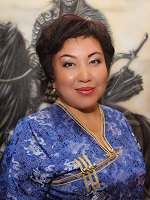Do the students of Kalmykia need Kalmyk language (according to sociological surveys of 2015 and 2017)
DOI:
https://doi.org/10.25178/nit.2018.1.12Keywords:
ethnocultural education; ethnolingual processes; Kalmyk language; Kalmyks; Kalmykia; youth; sociology of youthAbstract
One of the languages in Russia under the certain degree of danger of vanishing is Kalmyk language – a mother tongue for dominant ethnic group of the Republic of Kalmykia. Sociological surveys reveal that it is being spoken by less and less number of people. The language is shifting from the ethnodifferentiating feature to the symbolic attribute of an ethnos. Kalmyk language is occupied rarely as a mean of communication among youth, especially out of home (at work, school or public). Article presents the results of survey and juxtaposition of answers of Kalmyk youth and Kalmyk and Russian students.
Article fixes the low level of communication on Kalmyk language among youth. Only 43% of respondents were bilingual (speaking both Russian and Kalmyk) in 2015 and 46% - in 2017. Main reason for this is absence of Kalmyk language verbal environment rather than non-ability to speak the language.
Demand for learning the national language of the republic exists: only 4% of students polled said they don’t need to learn Kalmyk language, while 52.5% would select standard, 20% - extended, 18% - shallow level of learning Kalmyk language. In 2017 level of this demand significantly degraded and author sees reason for this in change of institutions in survey.
Explicit high demand among the students is learning foreign languages (English at first place). Significant less demand is for traditional courses of the history of region, history of ethnos and national culture. Nevertheless, youth are interested in exposure of national cultures but in form of practical learning in theaters, concerts or tourist treks rather than formal educational practices.
References
Bitkeeva, A. N. (2006) Kalmytskii iazyk v sovremennom mire (sotsiolingvisticheskii aspekt) [Kalmyk language in the modern world (sociolinguistic aspect)]. Moscow, Nauka. 366 p. (In Russ.).
Denisova, G. S., Denisova, A. V. and Namrueva, L. V. (2016) Etnokul'turnoe obrazovanie v Respublike Kalmykiia: sushchestvuet li ugroza formirovaniiu grazhdanskoi identichnosti [Ethno-cultural education in the Republic of Kalmykia: is there a threat to the formation of civic identity]. Vestnik Kalmytskogo instituta gumanitarnykh issledovanii RAN, no. 2, pp. 176–186. (In Russ.).
Diakieva, R. B. (2016) Iazykovaia politika i voprosy iazykovogo soznaniia titul'nogo etnosa (na primere Respubliki Kalmykiia) [Language policy and questions of language consciousness of the title ethnic group (by the example of the Republic of Kalmykia)]. In: Narody Kalmykii v sisteme evraziiskikh istoriko-kul'turnykh tsennostei: proshloe, nastoiashchee i perspektivy razvitiia [Kalmyk peoples in the system of Eurasian historical and cultural values: past, present and development prospects] / ed. by A. N. Ovshinov. Elista, ZAOr «NPP «Dzhangar». 272 p. Pp. 247–255. (In Russ.).
Makarova, G. I. (2010) Identichnosti tatar i russkikh v kontekste etnokul'turnykh politik Rossiiskoi Federatsii i Respubliki Tatarstan [Identity of Tatars and Russians in the context of ethno-cultural policies of the Russian Federation and the Republic of Tatarstan]. Kazan', Kazanskii universitet. 248 p. (In Russ.).
Namrueva, L. V. (2010) Kak kalmyki znaiut svoi iazyk [As the Kalmyks know the language]. Sotsiologicheskie issledovaniia, no. 4, pp. 138–141. (In Russ.).
Namrueva, L. V. (2014) Sovremennaia molodezh' i sostoianie kalmytskogo iazyka (po itogam sotsiologicheskogo analiza 2000-kh gg.) [Modern youth and the state of the Kalmyk language (based on the results of sociological analysis of the 2000s.)]. Rossiiskii akademicheskii zhurnal, no. 1, pp. 109–113. (In Russ.).
Namrueva, L. V. (2015) Iazyk etnicheskoi prinadlezhnosti [The language of ethnicity]. In: Namrueva, L. V. Etnicheskaia sotsializatsiia molodezhi Respubliki Kalmykiia (analiz 2000-2010-kh gg.) [Ethnic socialization of the youth of the Republic of Kalmykia (analysis of 2000-2010-ies.)]. Elista, Kalmytskii institut gumanitarnykh issledovanii RAN. 195 p. Pp. 71–85. (In Russ.).
Namrueva, L. V. (2017) Iazykovoe obrazovanie i gumanitarnyi predmetno-distsiplinarnyi tsikl v sisteme obrazovaniia Respubliki Kalmykiia v kontekste formirovaniia rossiiskoi identichnosti [Language education and humanitarian subject-disciplinary cycle in the education system of the Republic of Kalmykia in the context of the formation of Russian identity]. In: Realizatsiia gumanitarnogo predmetno-distsiplinarnogo tsikla v shkolakh i vuzakh v aspekte formirovaniia rossiiskoi identichnosti, vospitaniia grazhdanstvennosti i solidarnosti v regionakh Iuzhnogo federal'nogo okruga. Ekspertnyi doklad [Implementation of the humanitarian subject-disciplinary cycle in schools and universities in the aspect of the formation of Russian identity, civic education and solidarity in the regions of the southern Federal district. Expert report.] / ed. by G. S. Denisova. Rostov-na-Donu, “Fond nauki i obrazovaniia” Publ. 144 p. Pp. 101–117. (In Russ.).
Published
How to Cite
Issue
Section

Author(s) license holder(s) grant rights for their work to the journal (grantee of a license) under the simple non-exclusive open license in accordance with Art. 1286.1 «Open license for a research work, work of literature or fine arts», Civil Code of the Russian Federation.
New Research of Tuva publishes articles under the Creative Commons Attribution-NonCommercial license (CC BY-NC).
Since it is an open license, author(s) reserve the right to upload the article to their institutional repository, submit it to another journal (if it allows republications), or republish it on their own website (in full, or in part).
However, several conditions apply here:
a) The republished version must always contain the name(s) and affiliation(s) of the author(s), the original title and the hyperlink to the original version on the New Research of Tuva website;
b) It must be in open access, free of charge, and no category of readers must be in any way whatsoever advantaged over general readership.
c) should the contribution be submitted elsewhere by its author(s) without substantial modification (30% or more of original text unchanged), the body of the article should contain a disclaimer that the original version was published in New Research of Tuva (with a link to the respective page)
The CC-BY-NC is a non-revocable license which applies worldwide and lasts for the duration of the work’s copyright.









